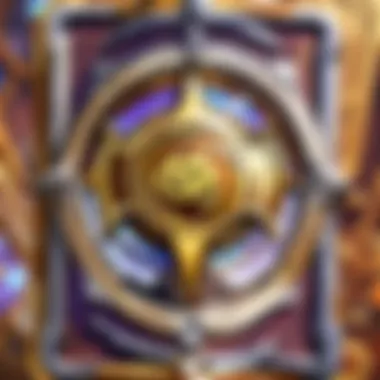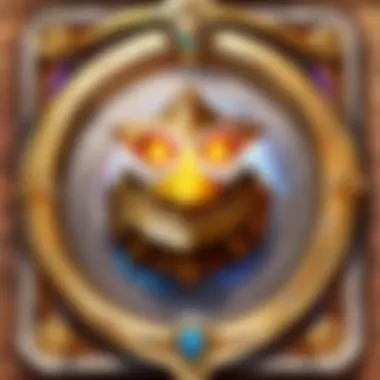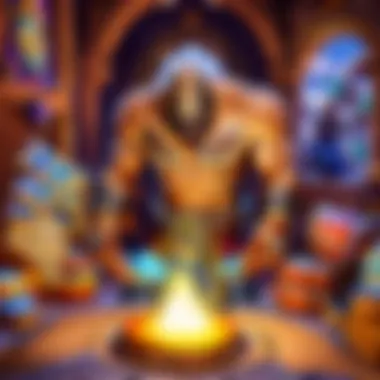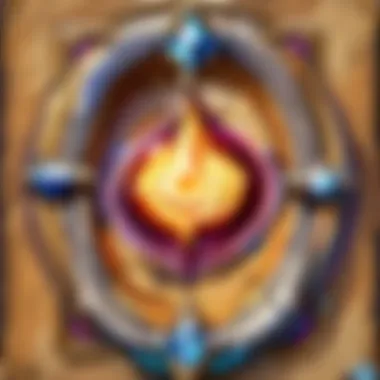Navigating Hearthstone's Future: Trends and Insights


Intro
The world of Hearthstone is not static. As players immerse themselves in the gameplay and current community dynamics, staying informed about future directions becomes essential. This article explores upcoming expansions, evolving strategies, and community trends. It provides players with critical insights that enhance their adaptability and overall gameplay experience.
Game Updates and Patches
To understand where Hearthstone is headed, one must first consider the game updates and patches. Blizzard consistently works on improving balance and enhancing player experiences through its updates.
Overview of the latest game updates and patches from Hearthstone
Refreshing the game is crucial for long-term engagement. Recent patches have brought noticeable changes in class-specific capabilities, card adjustments, and targeted balance fixes. Among notable updates this season, balance adjustments focused on less-played classes demonstrate the developer's intention to keep the playing field competitive. The reinforcement of Warlock's abilities has created new options for aspiring players.
Detailed breakdown of changes and its impact on gameplay
Examining the latest patch, various structural restructuring of cards has been implemented, largely focused on the competitive environment. Changes introduced, such as the Mana Cost alterations for specific cards, shifting power dynamics, benefitting slower-paced strategies. Importantly, the Draw Mechanics of certain cards now encourage a more tactical approach.
Analysis of new cards and mechanics introduced
Engagement with Hearthstone’s new mechanics will shape the future meta. For example, the introduction of cards that manipulate mana represent a significant strategic shift. Cards that integrate faction synergy add dimensions to deck-building, presenting new gameplay nuances that seasoned players should embrace.
Deck Strategies and Meta Analysis
Successful players in Hearthstone understand how to navigate the ever-changing meta landscape. As shifts happen following updates, developing strategic deck choices is vital.
Top deck recommendations for different play styles and skill levels
Players should look towards specific decks tailored to their preferred styles. Aggro strategies tend to excel for impulsive players, utilizing the Face Hunter archetype effectively. Conversely, control decks like Highlander Mage cater well to those seeking calculated gameplay.
Insight into the current meta and popular deck archetypes
Presently, disciplines in deck archetypes signal diverse gameplay options. Popular decks like Priest and Druid sustain effectiveness within the ranking systems. Understanding these archetypes can assist in bond farming, where knowledge of opponents becomes paramount.
Strategies for countering popular decks and tech choices
Foreseeing your opponent’s strategies involves honing your skill to effectively counter. Add in critical tech cards akin to you deploying Spells or minions that can dismantle key components of popular structures. The Siphon Soul can neutralize aggressive strategies, while Hex deals with the popular constructs in varied Shaman builds.
Card Reviews and Set Reviews
A deeper review of cards reveals burgeon new possibilities as more expansions come ubiquitously.
In-depth reviews of new cards and their potential impact on the meta
Engaging with novel cards becomes a routine workout in adaptation. Cards introducing unique mechanics such as Discover and structural enhancements shift paradigms used previously in the game.
Evaluations of card synergies within different deck archetypes
Each card functions autonomously, yet them establishing traction within various frameworks is essential for maximizing performance. For instance, complementing Quest Druid synergizes well with cards that revolve around 'Nature' spells whilst efficient crafting plays manifests accordingly.


Set reviews focusing on value, versatility, and competitive viability
New expansions must also undergo searing analyses for longevity in both casual and competitive play. Recent additions stack in value over time, especially when addressing variants that comply with evolving structures. Thus, influencing interactions amid cards elevates significance dramatically within Hearthstone’s ecosystem.
Player Guides and Tips
Already, we touched insights surrounding Hearthstone’s dynamics. Augmenting these insights comes through sharing practical tips that appeal to varying skill levels.
Beginner's guides to understanding core game mechanics and strategies
New players should familiarize with core mechanics focusing on mana usage, tempo, and position strategies. Fostering an analytical approach right from the beginning put novice players on an accelerated trajectory to improvement.
Advanced tips for improving gameplay and decision-making
For seasoned individuals looking to sharpen their experiences, an elegant deliberation of potential plays is fruitful. Taking advantage of available Health metrics to gauge opponent strengths, or weaknesses could determine shortly longer stride executions.
Arena drafting strategies and arena-specific gameplay tips
Entering the Arena necessitates distinct styles and preparedness by emergent strategic exits. Clarify Draft synergy, thereby ponder through letdowns when adapting deploying top-tier spells or utilizing combos available at choice.'
Understanding the Current State of Hearthstone
Understanding the current state of Hearthstone is essential for grappling with its future trajectory. Evaluating this popular digital collectible card game encompasses several facets: historical context, meta dynamics, and player interaction. Each of these areas offers invaluable insights for both new and returning players navigating the evolving landscape.
Historical Context and Evolution
Since its launch in 2014, Hearthstone has undergone significant evolution. Originally a simplistic card game based on the Warcraft lore, its periodic expansions have continually reshaped both mechanics and strategy. Each expansion brings a host of new cards and introduces varied themes, compelling players to adapt their approaches.
The introduction of mechanics such as Discover and Battlecry is a prime example of how continual evolution retains players' interest while keeping gameplay fresh. These changes are not mere cosmetic shifts. They affect how players build decks, counter opponents, and engage with the game strategically. Analyzing this backdrop is key to understanding current gameplay substance and anticipating future modifications.
Current Meta Analysis
Analyzing the current meta in Hearthstone sheds light on which decks and strategies are prevailing in play. This is often informed by new card releases and patch updates. At any given time, strong archetypes—like Aggro, Control, and Combo—emerge, providing various pathways to success. As of late 2023, strategies that focus on minion curve and resource management seem to dominate ladders.
Current players must remain alert to these dynamics. Being aware of which decks are impactful allows players to either align with those strategies or develop counters. This adaptation often determines winning outcomes in competitive matches.
Player Demographics and Engagement Patterns
The player base of Hearthstone exhibits diverse demographics and engagement patterns. New players entering the game opt straight for casual modes—including Friendly Challenges and Arena. Veteran players usually engage in ranked gameplay, focusing on ladder climbing and meta mastery.
In addition, community data shows an increasing trend of aggressive usage of digital resources: streamers dissecting complex strategies, forums buzzing with guide discussions, and social media channels filled with deck suggestions. Such resources nurture players of all levels. Hence, participation in online communities not only enhances understanding of current game mechanics but also encourages player retention over time.
Investment in understanding the existing state of Hearthstone equips both novice and expert players with tools necessary for navigating future trends effectively.
Key Trends Reshaping Hearthstone's Future
Hearthstone is a dynamic game that changes constantly. It adapts to player needs and industry standards. Understanding the key trends that shape its future can help players navigate the increasingly complex game landscape. This section focuses on innovations in game design, community-driven content creation, and changes in competitive play. Each trend makes a significant impact on how players experience the game and what they can expect moving forward. New trends can create opportunities for personal growth and competition. Here, we will explore specific aspects of these trends, discussing their benefits for different player segments.
Innovations in Game Design


New Card Mechanics
New card mechanics are essential in refreshing game flow and strategy. The introduction of various mechanics keeps the competitive environment exciting. Mechanics such as Discover and Rush allow for unique strategies and tactical depth. With well-structured card mechanics, not only field strategy may change, but also how players interact with each other during a match. This feature can result in higher engagement and excitement, making it a popular topic for the community. However, new mechanics can sometimes introduce complexity that may intimidate beginner players. Still, overall, these innovations contribute to retaining player interest.
Expansion of Lore and Theme
The expansion of lore enriches the player experience and strengthens their connection to the game. Hearthstone has a rich history that it continues to build upon. Players appreciate narratives that stem from the Warcraft universe. Promoting deeper lore encourages players to explore quests and story-based content. However, blending intensive lore into gameplay may pose a barrier for newcomers in terms of accessibility. The lore adds an emotional layer to the experience, and players who engage actively find gratification in knowing character backstories and world history.
Integration of Technology
Technology plays an essential role in shaping modern gaming trends. Hearthstone has embraced advancements that enhance gameplay efficiency. Mobile compatibility and digital innovation allow players to connect seamlessly to the game. This appeal spans across various demographics. However, there must be a balance. Players priorly favor ease of access yet could miss “traditional’’ tabletop experiences. integration of technology is a keynote bearer of innovation but it can create divides based on technical literacy among players.
Community-Driven Content Creation
Influence of Streamers and Content Creators
With the popularity of streamers and content creators has grown, so has their role in the Hearthstone community. Their influence often shapes strategies, deck choices, and gameplay styles. Watching expert gameplay can inspire viewers to cultivate their own skills. Engaging with streams also facilitates discussion about gameplay techniques, filling a significant gap in community interaction. However, dedicated followers may imitate strategies without personal adaptation, which can hinder skill development in the long term.
Role of Forums and Online Communities
Online communities and forums serve as a backbone for player interaction. Sites like Reddit are hubs for discussions and idea exchanges. Players share tips, deck lists, and news updates, creating a vibrant ecosystem. Community insights often shape opinions on the meta, enabling players to stay informed. Still, sifting through clouded narratives and conflicting advice can be challenging. Overall, the collective knowledge and camaraderie foster personal growth within the game.
Changes in Competitive Play
Format Evolution
The evolution of game formats must accommodate various player preferences and increasing competitiveness. Hearthstone regularly updates its ranked modes, bringing novelty to theway wins are achieved. Adaptable formats let players test combos against evolving metas, maintaining prolonged engagement and ambition. On the downside, changes may alienate devoted players. They who rely heavily on specific formats might find transitions abrupt or frustrating.
Prelims of New Tournaments
The additions of new tournaments create various pathways for players to showcase their talents. Whether casual or serious, new tournaments set fresh benchmarks for competition. Local and global events foster inspiration and camaraderie in the player base. In turn, heightened visibility may attract newcomers to competitive play. Alternatively, increased tournaments can create saturation. Players could feel overwhelmed by the options offered and struggle to decide where to invest time and effort.
Embracing these trends not only helps players adapt but enables a unified vision for the future of Hearthstone's evolving landscape.
Implications for Different Player Segments
Understanding the implications for various player segments is crucial in the current and future landscape of Hearthstone. Each group interacts with the game differently, allowing them to derive unique benefits and challenges. Recognizing their diverse experiences can greatly enhance the way players engage with the game, providing insights that help define improvements and paths moving forward.
Beginner Players
Skill Development Strategies
Skill development strategies offer a roadmap for new players enthusiastic to improve their abilities in Hearthstone. They emphasize understanding not only the basic rules but also expand into strategies from increasingly complex game-play. One key feature of these strategies is their structured progression, which allows beginners to build a solid foundation effectively. Implementing this practice promotes a more thorough knowledge of the game. However, some players might find it overwhelming, as mastering essential skills requires time and dedication.
Understanding Game Mechanics
Understanding game mechanics pertains to familiarizing oneself with every aspect that governs Hearthstone's operation. Learning about how phases work, how cards interact, and the significance of various archetypes can lead to better in-game performance. A notable advantage of this knowledge is that it boosts confidence, making beginners readily able to participate without fear of making mistakes. Contrarily, a key disadvantage is potential frustration when players face complexity without previous exposure.


Advanced Players
Meta Awareness and Adaptation
Meta awareness and adaptation signify a crucial aspect of gameplay for advanced players. It involves comprehending the current state of the game’s landscape, including popular decks and strategies. This insight allows players to tweak their own decks according to the evolving meta. One characteristic of this approach is its requirement for continual learning and analysis. While this promotes active engagement with the community, the downside includes the pressure of always keeping up-to-date in a fast-changing scenario.
Deck Optimization Techniques
Deck optimization techniques center around fine-tuning card selections and strategies to enhance success rates in plays. They should take into consideration efficiency and synergy among cards. This makes it a popular and advocated choice for serious players aiming for competitive edge. The unique feature of these techniques is that they often require time for testing and alterations. Sometimes, pre-existing strategies might not align, leading to inefficiencies.
Casual Players and Spectators
Engagement with Community Events
Engagement with community events offers casual players neutrality in their interaction with Hearthstone, exciting opportunities exist such as themed tournaments and online events, where players can come together without high-stake pressure. A primary characteristic of community events is that they foster connectivity and camaraderie among fans. Participation leads to fun experiences. However, casual players may find it difficult to remain engaged if events are scarce or poorly promoted.
Participating in Local Tournaments
Participating in local tournaments creates a competitive yet achievable atmosphere for casual Hearthstone players. Local gatherings provide a platform for socializing and friendly competition. This aspect helps to demystify some of the challenges presented by more established players and strengthens community bonds. A downside could be the pressure while facing skilled competitors, which may overwhelm those uninterested in competitive environments. Overall, locals events can motivate more casual players to push their own limits within the game.
Anticipated Challenges Ahead
Understanding the potential obstacles that lie ahead is important for Hearthstone’s continued evolution. As the game strives to innovate while maintaining player loyalty, specific challenges will emerge that impact both new and seasoned participants. Addressing these issues effectively will contribute to a more vibrant gaming community, thus sustaining Hearthstone’s relevance and appeal over time.
Balancing Competitive Integrity and Accessibility
Finding the right balance between competitive integrity and accessibility is crucial for Hearthstone. On one hand, players want a fair platform where skill and strategy dominate; on the other, a welcoming environment invites casual gamers.
Ensuring top-tier competitive integrity often involves stringent rules and a high entry barrier for players. This might alienate newcomers who struggle to keep pace. To counteract this, game developers must explore mechanisms that uphold fairness but lower the accessibility gap. Simple access points such as tutorials, guides, or progression metrics could encourage more engagement.
Additionally, creating events within a non-overbearing framework could allow casual players to experience high-stakes competition without the fear of overwhelming routes. This would foster a community that values craft while remaining inclusive.
Addressing Player Retention Issues
Retaining players is as important as acquiring new ones. Market research indicates fluctuating retention rates impact not just the ecosystem of Hearthstone, but also its economic sustainability. Failing to engage existing players can lead to dwindling participation, thereby harming the brand.
To tackle this, developers should implement periodic content updates, events, and ongoing promotions. Engaging players through seasonal content keeps the user experience fresh, capturing interest that might otherwise linger elsewhere. Communication via player surveys could help developers understand retention barriers. Most importantly, harnessing feedback loops—where player voices directly influence new features—could promote greater attachment to the game.
Moreover, recognizing how different player segments engage allows for tailored retention strategies. For example, advanced players might appreciate updated meta strategies while beginners need welcoming accessibility mitigators.
Managing Community Expectations and Feedback
Engaging with the community effectively is key to managing expectations and securing loyalty. A vast player base has distinct factions, wanting different features and content updates, which complicates direction and priorities.
Understanding community sentiments and balancing these expectations calls for an open dialog. Regular development blogs, comprehensive Q&A sessions, and addressing feedback in live streams are effective. This not only informs players of the future direction but also allows for a flow of communication on what they truly edgres for.
Community platforms like Reddit and Facebook offer windows into player sentiments. Active monitoring and quick responses can alleviate misunderstandings while conveying that player input holds significant weight. Overall, nurturing a strong connection portrays a company culture willing to engage and evolve based on player demands.
The End
In the fast-evolving world of Hearthstone, understanding the trajectory changes is vital for maintaining both interest and competitiveness in gameplay. The game’s landscape demands that players, regardless of their skill level, recognize the necessity of adapting strategies to keep pace with new card mechanics and gameplay trends.
The Importance of Adaptability
Adaptability is not just an asset but a crucial element in thriving within Hearthstone. The shifting dynamics of game mechanics often leave players wondering about the best approaches to take. Successful players often exhibit a keen ability to analyze the current meta and adjust accordingly. This means frequently evaluating cards, strategies, and even their overall play styles to match the current game environment.







